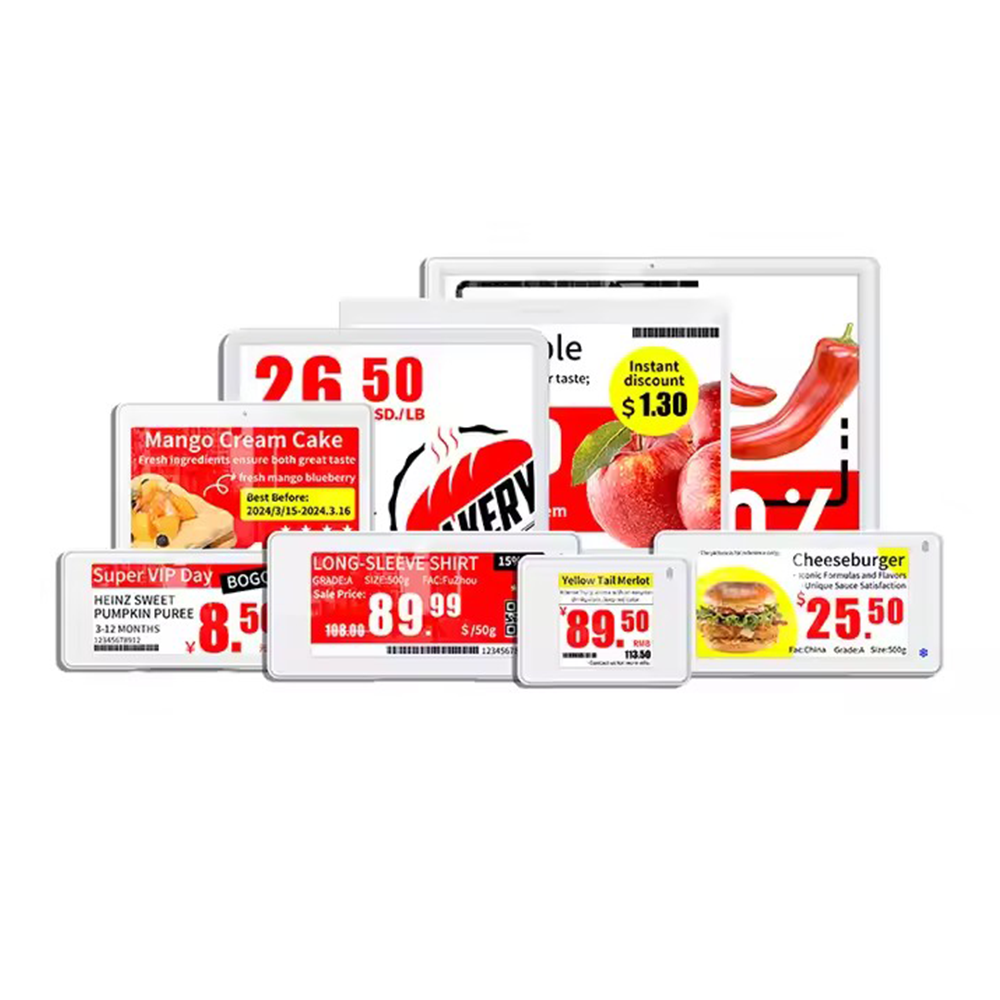תגיות מדף בחנויות של ימינו אינן עוד רק מציינות מחירים. הן משמשות כערוצי תקשורת חשובים, שגרי דגל של המותגים ואף עוזרות לחנויות להגביר מכירות. כאשר קונים בחרו בסגנון התג המתאים לכל מוצר, הם בעצם עוזרים לקונים לבחור טוב יותר, לחסוך זמן של ריצה ברחבי החנות ולשפר את המראה הכללי של המתקנים. הבחירה האופטימלית תלויה בסוג המוצר, בציפיות הלקוח ובהעדפות החנות מבחינת מטרות תפעוליות. לדוגמה, ירקות ופירות טריים עלולים להזדקקו לתגים פשוטים בהשוואה לאלקטרוניקה, שם פרמטרים טכניים מדויקים חשובים יותר לקונים מבוקרים.
תגיות מדף משמשות גשר בין המוצר ללקוח. בין אם משתמשים בתוויות נייר מסורתיות ובין אם בתצוגות דיגיטליות מתקדמות, הפורמט משפיע ישירות על הדרך בה קונים percipients את הערך, וודאות המידע והאיכות של המוצר.
העברת ערך המוצר היא קריטית. למוצרים שונים נדרשת סוגים שונים של מידע. לדוגמה, פריטי מזון מפיקים תועלת ממחיר ליחידה ומדפקי תוקף, בעוד שבחומרים אלקטרוניים עשוי להיות צורך בדפי טכניים או הדגשת מבצעים. פורמט התגית חייב לאפשר שילוב של תוכן זה ללא בלגן.
תמיכה בפעילות החנות היא עוד תפקיד חשוב של תגיות מדף. תיוג מדפים יעיל תומך במלאי מדויק, עמידה בתוכנית מדף (planogram) ועדכוני מחירים בזמן אמת. פורמט תגית מותאם ממזער את המאמץ הידני ומבטיח הצגה אחידה במדפים ובקטגוריות.
לכל קטגוריית מוצר יש צורך ייחודי. בחירת פורמט התוית הנכונה מתחילה בהבנת הדרישות האינפורמטיביות והויזואליות של כל קטגוריה.
ירקות ופירות טריים ופריטים בעלי תוקף קצר דורשים תוויות מדף שמ accent על טריות, מקור ומחיר לפי משקל. התוויות אמורות לכלול מחיר ליחידה ומחיר כולל, תאריך תפוגה או אריזה, ותעודה למקור המדינה או תעודת יבול אורגאני. פורמט נקי וברור יבטיח נראות גם בתנאי קירור או ערפיליות.
מוצרים שמגיעים באריזה צריכים תגיות אחידות ומחוסכנות שתחזיקו מעבר למראה בחנות. ברוב המקרים, התגיות מציינות את המחיר ליחידה, מבצעים נוכחיים, את סמל החברה או קוד QR שמאפשר לסרוק ולצפות במידע נוסף על המוצר. קונים נוטים להשתמש בתחומים בצבעים שונים על האריזות עמוסות כדי למשוך את תשומת הלב למבצעים או מוצרים חדשים. צירוף צבעים נכון עוזר לקונים לזהות את המבצעים בקלות, מבלי לקרוא כל תגית במאמץ.
תויות על פריטים בתחום הבריאות והיופי חייבות לכלול מגוון דברים, החל ממפרט טכני ועד תוכן שיווקי. בפועל, הגישה הטובה ביותר היא להשתמש בפורמטים מפורטים של תיוג שיכולים לכלול פרטים חשובים כמו דרגות הגנה UV, רשימות רכיבים, סמלוני אימות שכולם מחפשים, וכן לציין הצעות מיוחדות או דגשים dành für club members. חלק מחנויות מתחילות להסתגל לשימוש בתוויות דיגיטליות שעל המסך שלהן מופיעים מסרים שונים במהלך היום. תצוגות אלקטרוניות אלו למעשה משחררות מקום פיזי על המדף, ומאפשרות למוכרים להציג בו-זמנית מספר תמונות או קידומים מבלי לגרום לבולגן بصרי.
בנוגע לאלקטרוניקה ולגאדג'טים היקרים האלה, תגיות גדולות נוטות לעבוד טוב יותר. מה הסיבה? למכונות האלה צריך מקום כדי להציג את כל המפרט הטכני, תנאי האחריות, ואף פעמים הצעות מימון או חבילות מיוחדות. תגית טובה לא רק מציגה עובדות. גם חנויות מתחילות להשתמש באלמנטים אינטראקטיביים. חשבו על מסכים דיגיטליים שמציגים מידע ישירות מהמדף, או קודים ל-QR שצרכנים יכולים לסרוק עם הטלפונים שלהם. הסריקות מעבירות אותם ישירות לדף המוצרים המורחב באינטרנט. זה מקצר על הפעמים בהן הקונים נאלצים לפנות לעזרה של יועצי מכירות, אך עדיין נותנת להם גישה לכל המידע הרצוי לפני קבלת ההחלטה לרכישה.
לבוש ות accessories מפיקים תועלת מצגת אסתטית. אם כי לא תמיד על מדפים, תגים תלויים או תגים על מסילות בפורמטים מושכים יכולים לכלול גודל וסגנון, תיאור המותג, והנחות עונתיות. עקביות בשימוש בגופן, צבעים ואייקונים תומכת בזיהוי המותג ובעיצוב קל לנווט
טוב לפורמט תגית מדף מאזנים בין היררכיה ויזואלית לבין נתוני המוצר החיוניים. מספר גורמים צריכים להשפיע על החלטות בקשר לפורמט
גודל הגופן ובהירותו הם קריטיים. כל המידע החיוני כגון מחיר, שם ומספר היחידות צריך להיות קריא ממרחקים נפוצים של צפייה, בדרך כלל 30 עד 50 סנטימטרים. ניגודיות והפרדה בין האותיות הן מאוד חשובות לבהירות, במיוחד לקהל מבוגר יותר
מימדים ומקום תגית המדף צריכים להתאים לגודל המדף ולרוחב המוצר. תגיות גדולות מדי עשויות להסתיר את המוצר, בעוד שתגיות קטנות מדי עשויות להישכח. המיקום מתחת למוצר או לידו צריך לעקוב אחרי הנחיות תקניות בכל החנות כדי לשמור על עקביות.
צבעים וסמלים יכולים לשמש בצורה אסטרטגית. צבעים כמו אדום או כתום נפוצים במבצעים, ירוק למוצרים ידידותיים לסביבה, וכחול למחירים רגילים. עם זאת, שימוש מוגזם בצבעים עלול להחליש את ההשפעה הוויזואלית, ולכן יש לשמור על איזון.
עמידה בדרישות ותאימות הן גם חשובות. פורמט תגיות חייב לעמוד בתקנות כמו דיוק במחיר, ציון אלרגנים, וגילוי מקום המוצא. הן גם חייבות להיות תואמות למערכת POS או ERP של החנות כדי עדכונים חלקים.

עם העלייה בשימוש בסמלים דיגיטליים ותצוגות דיו-אלקטרוני, קונים יכולים כעת להתאים בדינמיקה את פורמט הסמלים. טכנולוגיות אלו מאפשרות עדכון בזמן אמת, כאשר מחירים, מבצעים ונתוני מוצר יכולים להיעדכן מרכזית ולהופיע מיידית על המדף.
קיימות גם אפשרויות של מסמכי תצוגה מרובים, כאשר תג אחד יכול להסתובב בין פורמטים שונים, לדוגמה, מציג מחירים ברגע מסוים ועובד על ידי תצוגת עובדות תזונתיות או קודים למבצעים בזמנים אחרים.
ניהול מרכזלי של תבניות מאפשר לפרוס תבניות ארגוניות באופן אחיד across מספר סניפים, תוך שמירה על שלמות המותג ופחת בזבוז כוח אדם.
פורמטים של תגי מדף צריכים להתאים גם למדיניות השיווק והמסחר. הדגשת מוצרים חדשים יכולה להתבצע באמצעות פורמטים מותאמים אישית עם סימונים של "מוצר חדש" או "הגע עכשיו" שמשיכים את תשומת הלב ומעוררי רצון ברכישת ניסיון.
מבצעים עונתיים מושפעים מפורמטים של תגים שפותחו כך שיתאימו לזמן של השנה, לדוגמה תגים עם פלטת אדומה בזמן חגיגות השנה החדשה הסינית, מה שמעמיק את האווירה החגיגית ומעורר את המכירות.
ניתן לתמוך בקידום צולב ובחבילות על ידי התאמת פורמטים של תוויות להצגת מוצרים קשורים, לדוגמה, "קנו את הדגנים האלה וקבלו 20% הנחה על חלב", תוך עידוד גדלי סל גדולים יותר.
כן, כל עוד הם ספציפיים לקטגוריה וויזואלית עקביים. לדוגמה, חטיפים ומשקאות יכולים להכיל פורמטים שונים, אך יש לשמור על רווחים, גופן וنمط צבעים אחידים המשקפים את הזהות החזקית של החנות.
בדיקות A/B במספר מיקומים או קטגוריות מוצרים יכולות להראות אילו עיצובי תגיות יוצרות תגובה טובה יותר מצד הלקוחות או שיעור המרה גבוה יותר.
התגיות הדיגיטליות מציעות גמישות גבוהה ופוחתות בזבוז נייר. הן יתרונו במיוחד לחנויות עם שינויים תכופים במחירי המוצרים, טווח רחב של מוצרים או מספר מיקומים.
רוכלים רבים משתמשים בתוכנת עיצוב תגיות המשולבת ב-POS או במערכות מבוססות ענן המאפשרות התאמת תבניות, יצירת ברקודים ובדיקות עמידה.
 חדשות חמות
חדשות חמות2024-09-14
2024-11-18
2023-11-14
2023-04-12
2019-07-11